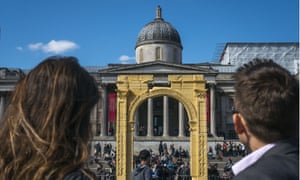
Mocking-up Palmyra in London’s Trafalgar Square (Report, 20 April) reminds me of that famous scene from Spinal Tap involving a mini Stonehenge. The intentions are good, but the outcome is lacking. The digital Triumphal Arch does, at least, draw attention to the tragic cultural losses that have occurred in Syria and elsewhere during the current conflict. But Roger Michel of the Oxford Institute for Digital Archaeology is wrong to think that a scanned copy might act as a plausible substitute.
New technology allows us to reproduce the form of an ancient structure more accurately than ever, but it can never recapture the spirit of the original which is the product of true ageing and change over generations. William Morris, founder of the Society for the Protection of Ancient Buildings, rightly felt that replication leads to “feeble and lifeless forgery”.
Damage at Palmyra is a tragedy, but it is a loss we must all accept. This barbaric act of destruction, intended to erase cultural heritage, is now part of the site’s long history. While there is an understandable inclination to reverse the damage, there is surely greater dignity in remembering and conserving what remains as a truthful record of the human and cultural losses. Elsewhere, we must concentrate on securing better protection for those ancient cultural icons that survive. It is welcome that the government has at last indicated its intention to ratify the 1954 Hague convention for the protection of cultural property in the event of armed conflict. This may help in future wars, but we should not pretend that digital copies can put things right in Syria. Je suis Palmyra, mais je ne suis pas Palmyra pastiche.
No comments:
Post a Comment